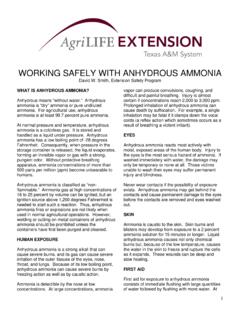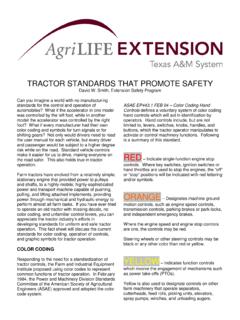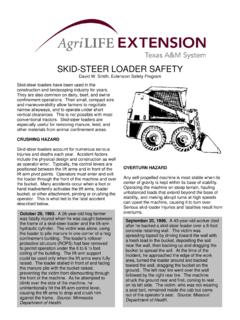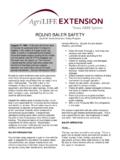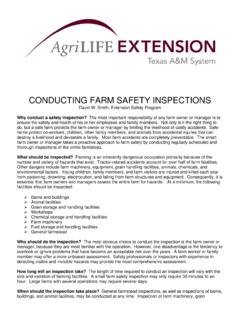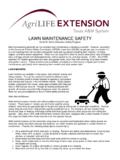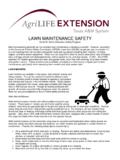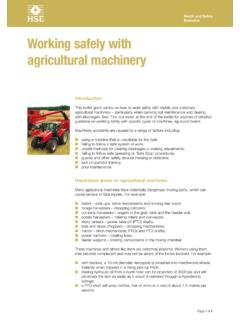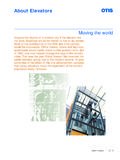Transcription of AGRICULTURAL MACHINERY SAFETY
1 AGRICULTURAL MACHINERY SAFETY David W. Smith, Extension SAFETY Program Modern farmers use a variety of machines to do farm work that used to require back-breaking labor. Today s MACHINERY is extremely specialized and designed to perform many different tasks. However, these mechanical systems share many of the same hazards that seriously injury and kill hundreds of farm workers each year. Agriculture remains among the most dangerous industries in the United States, although the threat of liability, litigation, and severe monetary penalties is causing AGRICULTURAL employers to give SAFETY an added emphasis. Occupational SAFETY and Health Administration (OSHA) regulations and worker protection standards now exist to promote safe workplaces and protect AGRICULTURAL workers.
2 Equipment manufacturers design MACHINERY with SAFETY in mind. They install guards, shields, warning decals, and color-coded parts to warn of potential hazards. Despite these advances, working with and around farm MACHINERY remains dangerous. Aged and homemade MACHINERY with missing and damaged guards and shields is common. Formal training on use of farm equipment is practically non-existent. This fact sheet will discuss the common causes of AGRICULTURAL MACHINERY injuries and deaths. All MACHINERY operators should be able to identify these hazards, provide safeguards and barriers to their exposure, and train all workers accordingly. Actual case descriptions are provided that illustrate the dangers and consequences of operating unsafe machines, and failing to recognize MACHINERY hazards.
3 SHEAR AND CUTING POINTS Shear points exist when the edges of two objects move toward or next to each other closely enough to cut relatively soft material. Cutting points happen when a single object moves forcefully or rapidly enough to cut. They are found with many types of crop cutting equipment, such as forage harvester heads, sickle bars, and grain augers. Shear and cutting points are hazardous because of their cutting force. They often move so rapidly that they may not be noticeable when in motion. February 24, 1995. A 27-year-old AGRICULTURAL maintenance worker was killed while repairing a silo bottom unloading auger. The victim was working inside a cement silo filled with corn silage, repairing a sweep auger that was damaged due to frozen feed inside the silo.
4 The victim was lying inside on the floor of the silo behind the auger SAFETY shield when he shouted that he was clear of the auger. A workmate outside at the electric control panel turned on the auger for approximately 15 seconds to dislodge frozen corn silage in the auger. During that time the victim apparently reached to move a trouble-light hanging near the auger, and got caught in the moving auger knives, severing his arm and shoulder, and causing severe chest injury. Source: Iowa FACE Report. PINCH POINTS Pinch points exist when two objects move together, with at least one of them moving in a circle. They are common in power transmission devices, such as belt and chain drives, feed rolls, and gear drives. Fingers, hands, and feet can be caught directly in pinch points or they may be drawn into pinch points by loose clothing that becomes entangled.
5 Contact may be made by brushing against unshielded parts or by falling against them. Machine manufacturers will cover pinch points with guards and shields that are removable for maintenance purposes. Unfortunately, many workers take off these guards for maintenance, but do not replace the shield when finished. Once someone is caught in a pinch point, machines generally move too fast for him or her to get out. Be aware of pinch point hazards and don t wear loose clothing that can become caught. Never reach over or work near rotating parts. Turn off MACHINERY before performing maintenance and replace all missing shields. WRAP POINTS Any exposed, rotating machine component is a potential wrap point. Protruding shaft ends can also become a wrap point. A cuff, sleeve, pant leg, or hair can catch on a rotating part and result in serious injury and death.
6 Entanglement with a wrap point can pull a person into a machine or wrap their clothing so tightly the person is suffocated. Contact with a wrap point may cause the person to loose balance and fall into other parts of the machine. Power take-offs (PTOs) and drive shafts are involved in the majority of serious wrap point injuries. Injuries occur when PTO guards and drive shaft shields become damaged or removed. To prevent wrap point injuries, wear tight-fitted clothing, put up hair, and look out for protruding bolts or U-joints that could snag clothing. Never attempt to reach over or climb under these rotating parts. CRUSH POINTS November 16, 1995. A 32-year-old male was killed when he was caught in a rotating PTO shaft. The farm worker was helping one of the owners of the farm load corn from the silage wagon into the feeding trough.
7 The PTO connecting the tractor to the silage wagon was not covered by a SAFETY guard. Recent heavy rains had made the area slick and muddy. The owner was nearby when he heard the victim yell. He found the victim wrapped around the rotating PTO. The farm worker suffered severe damage to the spinal cord, skull, and left leg. Source: Kentucky FACE Report. Crush points exist when two or more objects move toward one another, or when one object moves toward a stationary object. Hitching tractors to implements may create a potential crush point. Failure to block equipment safely can result in a fatal crushing injury. September 30, 1996. A 61-year-old dairy farmer was killed when his head was caught in a cattle feeding machine. The incident occurred at the family farm in the cattle feeding pen.
8 The victim was operating a center drive feeding machine, which directed corn from a nearby silo and transferred it to a conveyor belt that evenly distributed the feed into a 100-foot-long feeding trough. It is suspected that the farmer was trying to service the machine when his head was caught between the moving conveyor and a wooden support beam. Source: New Jersey FACE Report. Crushing injuries commonly happen to fingers and hands at the hitching point. If you are hitching equipment on the ground, while the tractor operator is backing the tractor, make sure to communicate clearly. Never put yourself or any part of your body between the tractor drawbar and implements. Never crawl underneath a machine or implement without first chocking and blocking equipment. Never rely solely upon the tractor s hydraulic system to keep raised equipment suspended.
9 March 16, 1999. A 71-year-old farmer was killed when a stock shredder he was working on fell and crushed him. He had raised it hydraulically and was working underneath it. The shredder was not blocked up and the hydraulic shutoff valves to the tractor (to which the shredder was attached) were not shut off. It appears the hydraulics on the tractor leaked at the connection which allowed the shredder to slowly fall on the victim. Source: Nebraska FACE Report. FREE-WHEELING POINTS The heavier a revolving part, the longer it will continue to rotate after power is shut off. Rotary mower blades, baler flywheels, and various other farm MACHINERY components will continue to move after power stops. Workers must allow time for these wheels or blades to stop before approaching them.
10 This may take as long as two minutes on some MACHINERY . PULL-IN POINTS Pull-in points usually occur when someone tries to remove or force in plant material or other objects that have become stuck in feed rolls or other MACHINERY parts. Many pull-in injuries involve round balers. The feed rollers on round balers occasionally clog when the hay is too wet, when the baler is pulled too fast, or when too much hay is being fed into the baler at one time. Rather than shutting down the baler by disengaging the PTO, some operators try to dislodge the clog by trying to pull the hay out by hand or by kicking the clog with the feet. Unfortunately, when jammed hay becomes dislodged, hands and feet are pulled in so fast that the worker cannot let go in time, and is pulled into the rollers.
